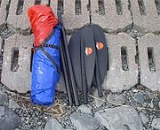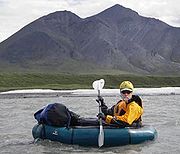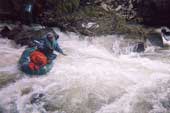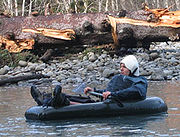
Packraft
Encyclopedia
Packraft and trail boat are colloquial terms for a small, portable inflatable boat
designed for use in all bodies of water, including technical whitewater
and ocean bays and fjords. A packraft is designed to be light enough to be carried for extended distances. Along with its propulsion system (collapsable paddles or lightweight oars) and safety equipment (PFD, clothing) the entire package is designed to be light and compact enough for an individual to negotiate rough terrain while carrying the rafting equipment together with supplies, shelter, and other survival or backcountry equipment. Modern packrafts vary from inexpensive vinyl boats lacking durability to sturdy craft costing over US $1,000. All weigh less than nine pounds (4 kg) and usually carry a single passenger. The most popular propulsion systems involve a kayak paddle that breaks down into two to five pieces. Most often they are paddled from a sitting position, although kneeling can be advantageous in some situations.
. However, Dick Griffith is documented to have used a packraft to descend Copper Canyon's Urique River
(Chihuahua, Mexico) in 1952 before introducing them to the Alaska Mountain Wilderness Classic
adventure race in 1982. Packrafts are now common equipment in that race.
A variety of companies have made durable packrafts in the past including Sherpa, Curtis, and American Safety. Furthermore, aviator emergency rafts have been used for packrafting purposes in a variety of applications. Pioneering use of packrafts generally consisted of using boats intended as pool toys or lake craft in moving water while carrying gear or passengers. The discomfort of these non-duarble boats led to the invention and marketing of the modern packraft.
, Sheri Tingey (founder of Alpacka Rafts), and Erin McKittrick (author of A Long Trek Home: 4,000 Miles by Boot, Raft and Ski), and her husband Bretwood Higman all are, or have been, based in Alaska. In the U.S. outside of Alaska, Forrest McCarthy, Nathan Shoutis, and Ryan Jordan (hiker)
have advanced backcountry packrafting in Wyoming, Montana, Washington, Utah, and Arizona. Packrafting has become popular in Norway and elsewhere in Europe. Packrafts have also been used in Mexico, Southeast Asia, Australia (including its Franklin River
), New Zealand, Patagonia, and tropical South America. Typically the boats are carried to cross and float rivers, streams and lakes while carried between watersheds.
Packrafts have historically been used as portable boats for long distance wilderness travel, usage that reached its apogee in the Higman-McKittrick 4,500 mile expedition along the Pacific Coast from Seattle to the Aleutian Islands. This classical use has been modified by most packraft owners to shorter day trips that mix trail hiking and river and creek floats or lake paddles. In Europe packrafts are used together with train travel. Most of these hike and paddle applications are in gentler water of Class II or less. However, low-flow steep creeks rated to Class V and other whitewater runs that were previously considered suitable only for kayaks and bigger rafts, are now run frequently by packrafters. The addition of spray decks and thigh straps allow more precise control of the craft. Eskimo rolling in packrafts is now done routinely. Packrafts are increasingly popular among fishers and hunters as well as travelers who wish to carry a lightweight craft on airplanes.
 Distinction from "Pool Toy."
Distinction from "Pool Toy."
In this article, packrafts/trail boats are differentiated from pool toys or flotation devices, which are intended for use in an enclosed and controlled body of water, such as a swimming pool. A packraft/trail boat is intended for use in open bodies of water.
Distinction from "Man-Portable."
A packraft is distinguished from a strictly man-portable raft insofar as it is designed to be light enough to represent only a fraction of the total weight an individual can reasonably carry. A packraft can be carried for extended periods, along with food, water, shelter, and other supplies that would enable the individual to traverse long distances through difficult terrain. All rafts listed in this article weigh less than five pounds without paddles or spray decks.



Inflatable boat
An inflatable boat is a lightweight boat constructed with its sides and bow made of flexible tubes containing pressurised gas. For smaller boats, the floor and hull beneath it is often flexible. On boats longer than , the floor often consists of three to five rigid plywood or aluminium sheets fixed...
designed for use in all bodies of water, including technical whitewater
Whitewater
Whitewater is formed in a rapid, when a river's gradient increases enough to disturb its laminar flow and create turbulence, i.e. form a bubbly, or aerated and unstable current; the frothy water appears white...
and ocean bays and fjords. A packraft is designed to be light enough to be carried for extended distances. Along with its propulsion system (collapsable paddles or lightweight oars) and safety equipment (PFD, clothing) the entire package is designed to be light and compact enough for an individual to negotiate rough terrain while carrying the rafting equipment together with supplies, shelter, and other survival or backcountry equipment. Modern packrafts vary from inexpensive vinyl boats lacking durability to sturdy craft costing over US $1,000. All weigh less than nine pounds (4 kg) and usually carry a single passenger. The most popular propulsion systems involve a kayak paddle that breaks down into two to five pieces. Most often they are paddled from a sitting position, although kneeling can be advantageous in some situations.
Pioneers
Pioneering use of packrafts is difficult to trace, as float tubes, inner tubes, and other small boats can in some of their uses be considered equivalent to packrafts, and have been used around the world for over a century, beginning with the Halkett boatHalkett boat
A Halkett boat is a type of lightweight inflatable boat designed by during the 1840s. Halkett had long been interested in the difficulties of travelling in the Canadian Arctic, and the problems involved in designing boats light enough to be carried over arduous terrain, but robust enough to be...
. However, Dick Griffith is documented to have used a packraft to descend Copper Canyon's Urique River
Urique River
-References:*Atlas of Mexico, 1975 .*The Prentice Hall American World Atlas, 1984.*Rand McNally, The New International Atlas, 1993....
(Chihuahua, Mexico) in 1952 before introducing them to the Alaska Mountain Wilderness Classic
Alaska Mountain Wilderness Classic
The Alaska Mountain Wilderness Classic is an adventure race that espouses purity of style. Started in 1982 as a wilderness footrace, the Classic has crossed various mountain ranges throughout Alaska, with some routes covering over...
adventure race in 1982. Packrafts are now common equipment in that race.
A variety of companies have made durable packrafts in the past including Sherpa, Curtis, and American Safety. Furthermore, aviator emergency rafts have been used for packrafting purposes in a variety of applications. Pioneering use of packrafts generally consisted of using boats intended as pool toys or lake craft in moving water while carrying gear or passengers. The discomfort of these non-duarble boats led to the invention and marketing of the modern packraft.
Contemporary Use
Alaska is generally considered the birthplace of packrafting as long distance, non-motorized, landscape travel across untracked wilderness necessitates a small, portable boat for water crossings. Dick Griffith, Roman Dial (author of Packrafting! An Introduction and How-to Guide), the Alaska Mountain Wilderness ClassicAlaska Mountain Wilderness Classic
The Alaska Mountain Wilderness Classic is an adventure race that espouses purity of style. Started in 1982 as a wilderness footrace, the Classic has crossed various mountain ranges throughout Alaska, with some routes covering over...
, Sheri Tingey (founder of Alpacka Rafts), and Erin McKittrick (author of A Long Trek Home: 4,000 Miles by Boot, Raft and Ski), and her husband Bretwood Higman all are, or have been, based in Alaska. In the U.S. outside of Alaska, Forrest McCarthy, Nathan Shoutis, and Ryan Jordan (hiker)
Ryan Jordan (hiker)
Ryan Jordan is a pioneer of the modern-day ultralight backpacking movement and founder of Backpacking Light Magazine.-Background:Jordan began his backpacking as a member of a Boy Scout troop in Burien, Washington. Jordan earned his Eagle Scout Award in 1986. In the late 1980s, he became involved at...
have advanced backcountry packrafting in Wyoming, Montana, Washington, Utah, and Arizona. Packrafting has become popular in Norway and elsewhere in Europe. Packrafts have also been used in Mexico, Southeast Asia, Australia (including its Franklin River
Franklin River
The Franklin River lies in the Franklin-Gordon Wild Rivers National Park at the mid northern area of the Tasmanian Wilderness World Heritage Area. Its source is situated at the western edge of the Central Highlands and it continues west towards the West Coast of Tasmania...
), New Zealand, Patagonia, and tropical South America. Typically the boats are carried to cross and float rivers, streams and lakes while carried between watersheds.
Packrafts have historically been used as portable boats for long distance wilderness travel, usage that reached its apogee in the Higman-McKittrick 4,500 mile expedition along the Pacific Coast from Seattle to the Aleutian Islands. This classical use has been modified by most packraft owners to shorter day trips that mix trail hiking and river and creek floats or lake paddles. In Europe packrafts are used together with train travel. Most of these hike and paddle applications are in gentler water of Class II or less. However, low-flow steep creeks rated to Class V and other whitewater runs that were previously considered suitable only for kayaks and bigger rafts, are now run frequently by packrafters. The addition of spray decks and thigh straps allow more precise control of the craft. Eskimo rolling in packrafts is now done routinely. Packrafts are increasingly popular among fishers and hunters as well as travelers who wish to carry a lightweight craft on airplanes.
Characteristics
A typical cold water set-up including packraft with thigh straps and spray deck, safety lines, paddle, suitable clothing (such as a dry suit), inflation bag, helmet, backpack, dry bag weigh 15 pounds (7 kg). While they can be inflated by mouth or electric pumps, most contemporary users carry light weight inflation bags.
In this article, packrafts/trail boats are differentiated from pool toys or flotation devices, which are intended for use in an enclosed and controlled body of water, such as a swimming pool. A packraft/trail boat is intended for use in open bodies of water.
Distinction from "Man-Portable."
A packraft is distinguished from a strictly man-portable raft insofar as it is designed to be light enough to represent only a fraction of the total weight an individual can reasonably carry. A packraft can be carried for extended periods, along with food, water, shelter, and other supplies that would enable the individual to traverse long distances through difficult terrain. All rafts listed in this article weigh less than five pounds without paddles or spray decks.
Usage
Packrafts are used in a variety of applications. These include:

- River Crossings .
- WhitewaterWhitewaterWhitewater is formed in a rapid, when a river's gradient increases enough to disturb its laminar flow and create turbulence, i.e. form a bubbly, or aerated and unstable current; the frothy water appears white...
(up to Class IV) . - Remote Lake FishingFishingFishing is the activity of trying to catch wild fish. Fish are normally caught in the wild. Techniques for catching fish include hand gathering, spearing, netting, angling and trapping....
. - Travel Boats .
- Adventure RacingAdventure racingAdventure racing is a combination of two or more endurance disciplines, including orienteering and/or navigation , cross-country running, mountain biking, paddling and climbing and related rope skills...
. - Open Water Crossings .
- Remote River Descents .
- HuntingHuntingHunting is the practice of pursuing any living thing, usually wildlife, for food, recreation, or trade. In present-day use, the term refers to lawful hunting, as distinguished from poaching, which is the killing, trapping or capture of the hunted species contrary to applicable law...
. - Canyoneering .
- Aviator Boats .
- Rock ClimbingRock ClimbingRock climbing also lightly called 'The Gravity Game', is a sport in which participants climb up, down or across natural rock formations or artificial rock walls. The goal is to reach the summit of a formation or the endpoint of a pre-defined route without falling...
Access .


